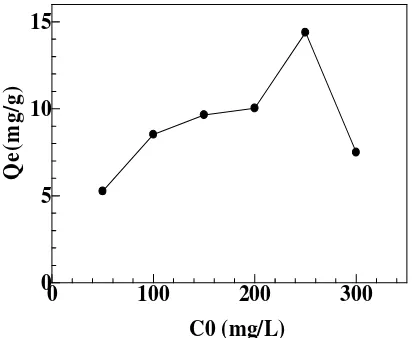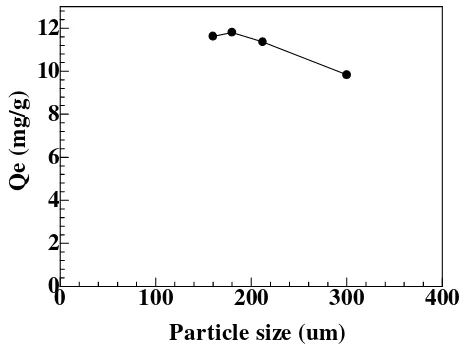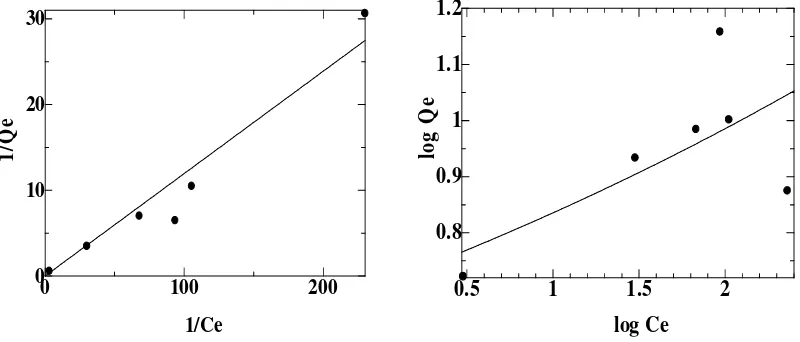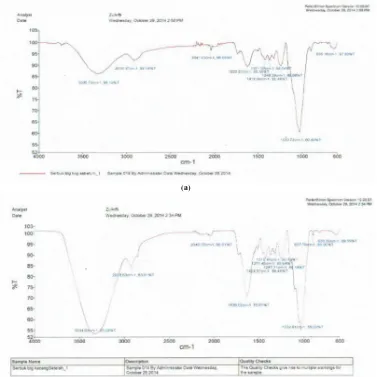Journal of Chemical and Pharmaceutical Research, 2015, 7(9S):94-100
Research Article
CODEN(USA) : JCPRC5
ISSN : 0975-7384
Biosorption of cadmium ion from aqueous solutions by low-cost soybean
waste (
Gliycine max
)
Harmiwati
a,b, Salmariza
b,c, Desi Kurniawati
b,d, Intan Lestari
b,e, Edison Munaf
b,
Reni Desmiarti
fand Rahmiana Zein
b*a
Department of Chemical Engineering of Natural Product, Polytechnic ATI Padang, Indonesia b
Department of Chemistry, Faculty of Mathematics and Natural Sciences, Andalas University, Padang, Indonesia c
Institute for Research and Standardization of Industry Padang, Ministry of Industry, Padang, Indonesia d
Department of Chemistry, Padang State University, Padang, Indonesia e
Department of Chemistry, Jambi University f
Department of Chemical Engineering, Bung Hatta University, Padang, Indonesia
_____________________________________________________________________________________________
ABSTRACT
Heavy metals are often considered as a main contaminant in water pollution and they are highly dangerous for living organisms in the contaminated area. This study focus on biosorption of cadmium (II) of soybean (glycine max) waste with the aim to predict the movement pattern of Cd(II) metals ions of wastewater. The studies included determination of optimum pH, optimum concentration, dosage of biosorbent, flow rate and type of isoterm. The results show that the optimum pH of biosorption Cadmium (II) on biosorbent was 5,the optimum concentration was 250 mg/l, the optimum biosorbent dosage was 0,1 g, the optimum flow rate was 3 ml/minute and the type of isotherm adsorption for the biosorption of on biosorbent were described as the isotherm Langmuir with R2 = 0,9746, and q max was 7,563 mg/g. This study shows that soybean waste can be an important low cost biosorbent for Cd(II) removal.
Keywords: biosorption, cadmium (II), biosorbent, biomass, soybean waste.
_____________________________________________________________________________________________
INTRODUCTION
Industrialization effect has increased in the discharge of industrial wastes, such as heavy metals into wastewater. The heavy metals in the environment such as wastewater have brought about a number of environmental problems [1,2]. The concentration of heavy metals in wastewater must be controlled because quality must to meet the water quality standard. The heavy metals are hazardous to human and the other living organisms [3,4]. Heavy metals in wastewater are not biodegradable and the removal of them is extremely important in terms of healthy of living organism [5,6]. The heavy metals can cause several unwanted effects, including disruption of the biosynthesis of hemoglobin blood, anemia disease, rising in blood pressure, kidney damage, disruption of nervous brain systems, diminished learning abilities of children, adrenal insufficiency, blindness, liver disfunction, and the others diseases.
of heavy metal ions from the wastewaters. Generally, biosorbent was contains several variety of organic compounds such as lignin, cellulose and hemicelluloses and functional groups such as hydroxyl, carbonyl and amino. Both organic compounds and functional groups in biosorbent have highly affinity for metal ion complexation in biosorption. The primary advantages of this method are more effective in the removal of the concentration of heavy metal ions to permitable levels using low cost biomass materials [2-8]. In recent years biomass used in biosorption process was plant waste or industrial by product such as Phaleria macrocarpa seed [23], Annona muricataL. seeds [7,12,13], Lansium domesticum Corr fruit peels [14] and seeds [15], Eggshells [16], Peanut shells[17], Coconut corr [18], rice husk [19], Nypa fruticans Merr Shell [22] and others. In this research biomass used as biosorbent from stem of soybeans waste. The aim of the present research was to investigate the potential that soybean waste as low cost biosorbent can be important for Cd(II) removal.
EXPERIMENTAL SECTION
Chemical and Equipments
All chemical used in this experiments such as Cd(NO3)2, HNO3, NaOH, HCl, Buffer solutions are analytical grade
from Merck. Distilled water was made from laboratory. A Crusher, Mortal Grinding, pH meter, analytical balance, oven, adsorbate column, AAS and FTIR were used in this experiments.
Preparation of Biosorbent
Stem of soybean waste was collected from agriculture waste in Pasaman Barat, West Sumatera, Indonesia. The stem was cut about 5 cm washed with water, dried at room temperature, grinded and sieved to obtain the particle size
≤200 µm. The powder was found soaked with 0.01 M HNO3 for 2 hours. Filtered then rinsed with distilled water
until neutral with pH about 7. The biosorbent were dried and ready to beused.
Continuous Adsorption
Powder of soybean waste biosorbent was entered into adsorption column and contacted with 15 mL solution containing Cd(II) ion. The experiments were conducted by varying pH solution, initial concentration, biosorbent mass, particle size of biosorbent and flow rate of Cd(II) ion metal.
Data Analysis
To determination the amount of Cd(II) ion adsorbed by soybean waste in adsorption process, the formula used is:
=
−
Where Qe is adsorption capacity (mg/g), Co is the initial concentration of metal ion (mg/L), Ce is the final concentration at equilibrium of process (mg/L), m is biosorbent mass(g) and Vis volume solution (L).
RESULTS AND DISCUSSION
Effect of pH solution
In biosorption process pH solution was an important role. This pH parameter affects the chemical properties of metal ion and the ability of biosorbent to adsorb metal ions [5]. Fig.1 shows that the effect of pH solution for the adsorption of Cd(II) ions by powdered soy bean waste in the pH range 2-6. The net charges of present on the surface of soybean waste of the biosorbent surface so greatly depend on the intial pH of metal ion. The results in Fig.1 indicate that soybean waste was ineffective at pH< 3. At the pH between2 to 5, can reasonably be described to a decreased H+ concentration in the solution and consequently increasing the number of negative charge on the biosorbent surface, This situation increased the electrostatic attraction and sorption of positively charge Cd(II) ions and then increased the amount of metals ion sorbed [20]. At the pH >5 precipitation of insoluble hydroxides of Cd(II) ion was occurred in the solution after adsorption. This optimum pH value founded5 was used in all the further experiments carried out to explore the effects of the other operating variable in experiment of biosorption.
Effect of Initial Concentration
several factors such as the collision between the metal ions with the biosorbent surface and the ability to diffuse on the biosorbent surface. Highly capacity is due to the availability of active sites on the biosorbent surface, when the number of active sites of biosorbent used is greater than the metal ions adsorbed, the adsorption capacity was founded will increase until the amount of the active site of biosorbent is equal with the number of Cd(II) ions, decreasing occurred after the equilibrium is reached between metal ion in adsorbat and active site of biosorbent[19]. High intial metal concentration can to accelerate the driving force and reducing the mass transfer resistance.
Figure 1. Effect of solution of pH on the biosorption capacity of Cd(II) ions on soybean waste. Experimental condition: Initial concentration = 100 mg/L, biosorbent dose = 0.1 g, for 15 mL metal ion
Figure 2. Effect of initial concentration on the biosorption capacity of Cd(II) ion soybean waste. Experimental condition: solution of pH = 5, biosorbent dose = 0.1 g, for 15 mL metal ion 100 mg/L
Effect of Biosorbent dosage
The biosorption capacity (Qe) for a given intial concentration of ion metal was defined by biosorbent dosage, which was one of important parameters. The effect of biosorbent dosage of soybean waste that usedwas examined by varying dosage at the range from 0.1 to 1.0 g. The result of experiment is shown in Fig. 3. This experiment shows that the maximum soybean waste biosorbent mass are 0.1 g. The decreasing of adsorption capacity were caused by the saturation between active site of biosorbent and metal ion and particle interactions such as aggregation by an increasing in soybean waste biosorbent mass [19,25].
Figure 3. Effect of biosorbent dosage on the biosorption capacity of Cd(II) ion on soybean waste. Experimental condition: Cd(II) ion concentration = 250 mg/L, solution of pH solution = 5, for 15 mL metal ion
Effect of particle size
The other effective parameter on molecules adsorption is particle size. Maximum uptake of adsorption process is a function of specific surface or external surface of adsorbent [24]. A series of experiments were performed in the range of soybean waste particles size between 160 -300 µm. According to Fig. 4, it is observed that the rate of cadmium adsorption was affected by the change in the particle size in surface area of the soybean waste biosorbent. From Fig. 4 was found optimum particle size 180 µm.
Figure 4. Effect of particle size on the biosorption capacity of Cd(II) ion on soybean waste. Experimental condition: solution of pH = 5, initial concentration = 250 mg/L and biosorbent dose = 0.1 g, for 15 mL metal ion
Effect of metal ion flow rate
In continuous adsorption system process, ion metal flow rate was one of significance parameters. The effect of metal ion in biosorption used was examined by varying flow rate at the range from 1 to 5 mL/minute. The result is shown in Fig. 5. This experiment shows that the ion metal flow rate which can bind maximum metal ions for flow rate was 3 mL/minute. The decreasing of adsorption capacity were caused by the saturation between active site of biosorbent and metal ion, and particle interactions such as aggregation by an increasing in ion metal flow rate.
Figure 5. Effect of flow rate metal ion on the biosorption capacity of Cd(II) ion on soybean waste. Experimental condition: solution of pH = 5, initial concentration = 250 mg/L and biosorbent dose = 0.1 g particle size 180 µm, for 15 mL metal ion
Adsorption Isotherm
The Langmuir adsorption isotherms model were studied from previous initial concentration of Cd(II) metal ions and shown in Fig. 6. The adsorption isotherm describes the process of adsorption of molecules distributed between solid phase and liquid phase when adsorption reached the equilibrium and used to describe the interaction between the metal ions with soybean waste biosorbent [14]. The adsorption of metal ions by soybean waste following Langmuir isotherm models with determination coefficient for Cd(II) ions is 0.9746. This indicates that the adsorption process occurs in a homogeneous surface with a monolayer adsorption. Chemical adsorption is explained by the interaction between the active site soybean waste adsorbent with adsorbate involving chemical bonds, so the Langmuir isotherm models explain the process of chemical biosorption [8]. However, based on the value of N in Freundlich isotherm models from experiment, it can also be said that the adsorption of both biosorbent shows physical sorption process, because it has a value of N > 1. The value of N indicates that the degree of nonlinear between solution concentration and adsorption, where N = 1, is the linear adsorption, N<1, adsorption through chemical processes and N > 1 adsorption through occured physical process [20].
Figure 6. Langmuir (a) and Freundlich (b) isotherm model for Cd ion biosorption on soybean waste
Table 1. Langmuir and Freundlich isotherm model parameter
Langmuir Freundlich
Qmax(mg/g) KL R2 Kf N R2
7.563 0,1322 0,9746 1,8316 2,17 0,648
Fourier Transform Infra Red (FTIR) Spectroscopy Analysis
The FTIR analysis of soybean waste was shown in Fig. 7. The spectrum for soybean waste biosorbent before adsorption (Fig.7a) demonstrates distinct peak at 3335.76 cm-1representating O-H bond in alcohol, peak at 2919.37 cm-1 representing C-H stretching, peak at1622.97 cm-1 representing C=O in ester. Thus, soybean waste biosorbent showed an abundance of carboxyl and hydroxyl groups. After adsorption were observed several difference shifts of peak (Fig. 7b). Spectrum 3334.93 cm-1, 2918.53 cm-1 and 1635.02 cm-1 show the adsorption band shift and indicate the change of functional groups with metal ions. The results of the biosorption process study also take place at the use of metal ion adsorption by Annona muricata L. by M.I. Kurniawan [11].
(a)
Figure 7. FT-IR spectrum of soybean waste powder (a) before and (b) after biosorption
CONCLUSION
good agreement with the experimental data as compared to Freundlich. The results indicate that soybean waste may be used as an inexpensive, effective and easily used adsorbent for the removal of cadmium from aqueous solutions.
REFERENCES
[1] N. Azouaoua, Z. Sadaouia, A. Djaafri, H. Mokaddem. J.Hazard Mater, 2010, 418: 126–134 [2] R. Zein, R. Suhaili, F.Earnestly, Indrawati and E. Munaf. J. Hazard. Mater. 2010, 181 : 52-56 [3] A.I. Okoye, P.M. Ejikeme, and O.D. Onukwuli. Int. J. Environ. Sci. Tech. 2010, 7 (4) : 793-800 [4] S.N.A. Abas, M.H.S. Ismail, M.L. Kamal and S. Izhar. World. Appl. Sci. J. 2013, 28(11) : 1518-1530 [5] Fumihiko Ogata, Hisato T, Hitoshi Y, Naohito K, J Oleo Science. 2013. 60 (7), 363-368
[6] P.R. Kumar, P.A. Swathantra, V.V.B. Rao and S.R.M. Rao. J. App. Sci. 2014, 14(13) : 1372-1378
[7] Z. Abdullah, M. I. Kurniawan, R. Zein, H. Aziz and E. Munaf. Res. J. Pharm. Biol. Chem. Sci2013, 4(4) : 1443-1451.
[8] N. Nazaruddin, D. Arrisujaya, Hidayat, R.Zein, E. Munaf and J-ye Jin. Res. J. Pharm. Biol. Chem. Sci2014, 5(2): 1619-1629
[9] M. Sahlan and I. Pramadewi. Int. J. Pharm. Bio. Sci. 2012, 3(3) : 472-478
[10] Rabyah B. A., I.J. Atangwho, N. Kuar, E.A.H. Mohamed, A.J. Mohamed, M.Z. Asmawi and R. Mahmud. J.Med. Plants Res. 2012, 6(10) : 1982-1990
[11] R. Hendra, S. Ahmad, E. Oskoueian,A. Sukari and M. Y. Shukor. BMC Comp. Alternative Med. 2011, 11; 3-10 [12] S. Amelia, F. Armila, P. N. Sari, R. Putri, R. Zein, M. Efdi and E. Munaf. Res. J. Pharm. Biol. Chem. Sci2014,5(5) : 1339-1345
[13] M.I. Kurniawan, Z. Abdullah, A. Rahmadani, R. Zein and E. Munaf. Asian J. Chem. 2014, 26(12) : 3588-3594 [14] Khoiriah, F. Furqoni, R. Zein and E. Munaf. J. Chem. Pharm. Res. 2015, 7(1) : 546-555
[15] W. Dilla, Furqoni, F, A. Widya, Khoiriah, Indrawati, R. Zein, and E. Munaf. Res. J. Pharm. Biol. Chem. Sci.2014, Vol 5(5), 1320-1328
[16]W.P. Putra, A. Kamari, S. N. M. Yusoff, C. F. Ishak, A. Mohamed, N. Hashim and I.Md. Isa. J. Encapsulationand Adsorption Sciences 2014, 4 : 25-35
[17] S. Tasar, F. Kaya and A. Ozer. Journal of Environt. Chem. Engineering 2014, 2: 1018-1026
[18] SNM. Yusoff, A. Kamari, WP Putra, CF Ishak, A. Mohamed, N. Hashim and IM Isa. Journal of Envi.Protection 2014, 5 : 289-300
[19] Z. Chaidir, D.T. Sagita, R. Zein and E. Munaf. J. Chem. Pharm. Res., 2015, 7(1) : 589-599 [20] A.M. Farhan and A.S. Sameen. American J. Environ. Eng. 2014, 4(1) : 11-17
[21] K. Huang, Y. Xiu and H. Zhu. Environ. Sci. Pollut. Res. 2013, 30 : 5930-5938.
[22] N. Nazaruddin, R. Zein and E. Munaf, Jiye Jin. J. Chem. Pharm. Res., 2014. 6(12):370-376. [23] Ali N.N, Yasherly. A, R. Zein, H. Aziz and E.Munaf. J. Chem. Pharm. Res.,. 2015, 7(7):189-196 [24] A. Shafaei, F.Z. Ashtiani, T. Kaghazchi, Chem. Eng. J. 2007. 133: 311–316.



